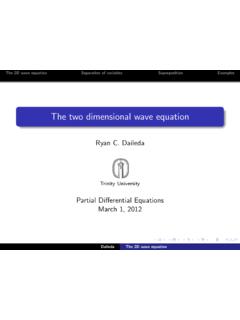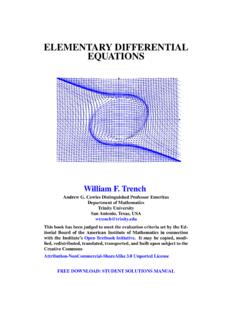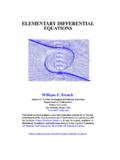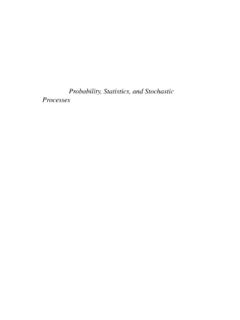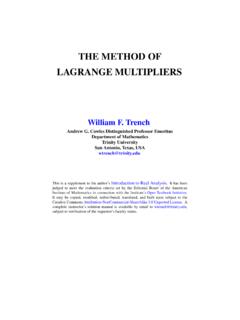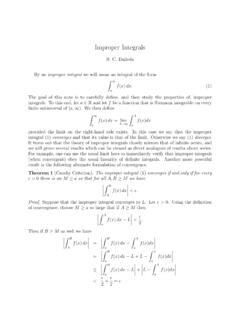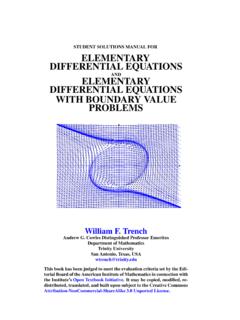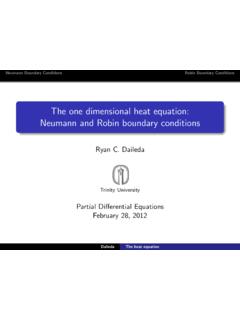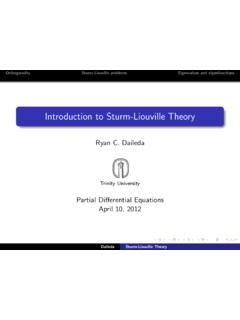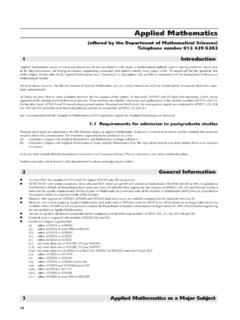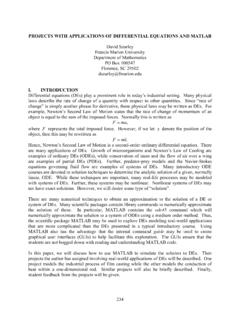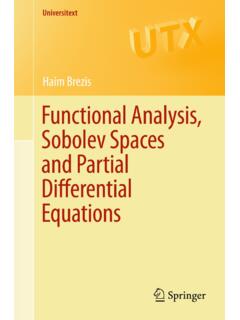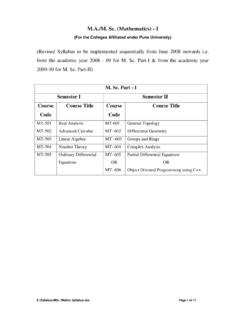Transcription of ELEMENTARY DIFFERENTIAL EQUATIONS WITH …
1 ELEMENTARYDIFFERENTIAL EQUATIONS WITHBOUNDARY VALUE PROBLEMSW illiam F. TrenchAndrew G. Cowles Distinguished Professor EmeritusDepartment of MathematicsTrinity UniversitySan Antonio, Texas, book has been judged to meet the evaluation criteria setby the Edi-torial Board of the American Institute of Mathematics in connection withthe Institute sOpen Textbook Initiative. It may be copied, modified, re-distributed, translated, and built upon subject to the Creative CommonsAttribution-NonCommercial-ShareAl ike Unported DOWNLOAD: STUDENT SOLUTIONS MANUALFree Edition (December 2013)This book was published previously by Brooks/Cole Thomson Learning, 2001.
2 This free edition is madeavailable in the hope that it will be useful as a textbook or reference. Reproduction is permitted forany valid noncommercial educational, mathematical, or scientific purpose. However, charges for profitbeyond reasonable printing costs are BEVERLYC ontentsChapter 1 Applications Leading to DIFFERENTIAL First Order Direction Fields for First Order Equations16 Chapter 2 First Order Linear First Order Separable Existence and Uniqueness of Solutions of Nonlinear Transformation of Nonlinear EQUATIONS into Separable Exact Integrating Factors82 Chapter 3 Numerical Euler s The Improved Euler Method and Related The Runge-Kutta Method119 Chapter 4 Applications of First Order Growth and Cooling and ELEMENTARY Autonomous Second Order Applications to Curves179 Chapter 5
3 Linear Second Order Homogeneous Linear Constant Coefficient Homogeneous Nonhomgeneous Linear The Method of Undetermined Coefficients The Method of Undetermined Coefficients Reduction of Variation of Parameters255 Chapter 6 Applcations of Linear Second Order Spring Problems Spring Problems Motion Under a Central Force296 Chapter 7 Series Solutions of Linear Second Order Review of Power Series Solutions Near an Ordinary Point Series Solutions Near an Ordinary Point Regular Singular Points Euler The Method of Frobenius The Method of Frobenius The Method of Frobenius III378 Chapter 8 Laplace Introduction to the Laplace The Inverse Laplace Solution of Initial Value The Unit Step Constant Coefficient EQUATIONS with Piecewise Continuous Constant Cofficient EQUATIONS with A Brief Table of Laplace TransformsChapter 9 Linear Higher Order Introduction to Linear Higher Order Higher Order Constant Coefficient Homogeneous Undetermined Coefficients for Higher Order Variation of Parameters for Higher Order Equations497 Chapter 10 Linear Systems of DIFFERENTIAL Introduction to Systems of DIFFERENTIAL Linear Systems of DIFFERENTIAL Basic Theory of Homogeneous Linear
4 Constant Coefficient Homogeneous Systems Constant Coefficient Homogeneous Systems Constant Coefficient Homogeneous Systems Variation of Parameters for Nonhomogeneous Linear Systems568 Chapter 11 boundary Value Problems and Fourier Eigenvalue Problems fory + y= Fourier Series Fourier Series II603 Chapter 12 Fourier Solutions of Partial DIFFERENTIAL The Heat The Wave Laplace s Equation in Rectangular Laplace s Equation in Polar Coordinates666 Chapter 13 boundary Value Problems for Second Order Linear boundary Value Sturm Liouville Problems687 PrefaceElementary DIFFERENTIAL EQUATIONS with boundary Value Problemsis written for students in science, en-gineering, and mathematics who have completed calculus through partial differentiation.
5 If your syllabusincludes Chapter 10 (Linear Systems of DIFFERENTIAL EQUATIONS ), your students should have some prepa-ration in linear writing this book I have been guided by the these principles: An ELEMENTARY text should be written so the student can readit with comprehension without toomuch pain. I have tried to put myself in the student s place, and have chosen to err on the side oftoo much detail rather than not enough. An ELEMENTARY text can t be better than its exercises. Thistext includes 2041 numbered exercises,many with several parts. They range in difficulty from routine to very challenging. An ELEMENTARY text should be written in an informal but mathematically accurate way, illustratedby appropriate graphics.
6 I have tried to formulate mathematical concepts succinctly in languagethat students can understand. I have minimized the number ofexplicitly stated theorems and def-initions, preferring to deal with concepts in a more conversational way, copiously illustrated by299 completely worked out examples. Where appropriate, concepts and results are depicted in I believe that the computer is an immensely valuable tool for learning, doing, and writingmathematics, the selection and treatment of topics in this text reflects my pedagogical orientation alongtraditional lines. However, I have incorporated what I believe to be the best use of modern technology,so you can select the level of technology that you want to include in your course.
7 The text includes 414exercises identified by the symbolsCandC/G that call for graphics or computation and are also 79 laboratory exercises identified byL that require extensive use of technology. Inaddition, several sections include informal advice on the use of technology. If you prefer not to emphasizetechnology, simply ignore these exercises and the are two schools of thought on whether techniques and applications should be treated together orseparately. I have chosen to separate them; thus, Chapter 2 deals with techniques for solving first orderequations, and Chapter 4 deals with applications. Similarly, Chapter 5 deals with techniques for solvingsecond order EQUATIONS , and Chapter 6 deals with applications.
8 However, the exercise sets of the sectionsdealing with techniques include some applied oriented ELEMENTARY DIFFERENTIAL EQUATIONS texts are occasionally criticized as being col-lections of unrelated methods for solving miscellaneous problems. To some extent this is true; after all,no single method applies to all situations. Nevertheless, Ibelieve that one idea can go a long way towardunifying some of the techniques for solving diverse problems: variation of parameters. I use variation ofparameters at the earliest opportunity in Section , to solve the nonhomogeneous linear equation, givena nontrivial solution of the complementary equation.
9 You may find this annoying, since most of us learnedthat one should use integrating factors for this task, whileperhaps mentioning the variation of parametersoption in an exercise. However, there s little difference between the two approaches, since an integratingfactor is nothing more than the reciprocal of a nontrivial solution of the complementary equation. Theadvantage of using variation of parameters here is that it introduces the concept in its simplest form andviiviiiPrefacefocuses the student s attention on the idea of seeking a solutionyof a DIFFERENTIAL equation by writing itasy=uy1, wherey1is a known solution of related equation anduis a function to be determined.
10 I usethis idea in nonstandard ways, as follows: In Section to solve nonlinear first order EQUATIONS , such as Bernoulli EQUATIONS and nonlinearhomogeneous EQUATIONS . In Chapter 3 for numerical solution of semilinear first order EQUATIONS . In Section to avoid the necessity of introducing complex exponentials in solving a second or-der constant coefficient homogeneous equation with characteristic polynomials that have complexzeros. In Sections , , and for the method of undeterminedcoefficients. (If the method of an-nihilators is your preferred approach to this problem, compare the labor involved in solving, forexample,y +y +y=x4exby the method of annihilators and the method used in Section )Introducing variation of parameters as early as possible (Section )
